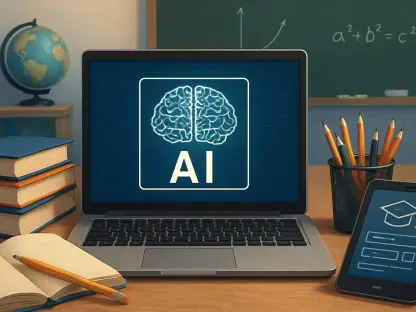The collaboration between Concordia University’s Gina Cody School of Engineering and Computer Science and Hitachi Cyber aims to tackle a significant challenge in cybersecurity: the overwhelming influx of events and alerts that threaten to flood modern Security Operation Centers (SOCs). This initiative seeks to revolutionize how security analysts from both industrial corporations and governmental organizations identify and prioritize cybersecurity threats. By harnessing the power of generative artificial intelligence (AI), the partnership aims to assist SOC analysts in automating the investigation of security events and incidents, thereby enhancing efficiency and accuracy in threat detection and response.
The Challenge of Modern Cybersecurity
Overwhelming Data and Alert Fatigue
The modern digital infrastructure encompasses extensive and vulnerable attack surfaces, generating unprecedented data that SOC teams must sift through to track adversarial activities. This deluge of information has already taxed SOC teams, making their task increasingly cumbersome. Cybersecurity operations are evolving in complexity, with threat actors continually changing their techniques, tactics, and procedures to evade existing defenses. This dynamic environment makes it difficult to distinguish between benign and malicious behaviors, leading to a surge in alerts.
In the face of these challenges, SOC teams often find themselves overwhelmed by the sheer volume and velocity of security data they must analyze daily. The complexity of modern networks and the sophistication of cyber threats have created an environment where traditional methods of threat detection and analysis are insufficient. This scenario results in a constant state of high alert within SOCs, where analysts must process vast amounts of information, identify potential threats, and respond in real time. Unfortunately, the high frequency of alerts, many of which are not genuine threats, exacerbates the problem, leading to what is known as alert fatigue.
The Impact of False Positives
Alarmingly, a significant proportion of these alerts are false positives, which are incorrect signals indicating a threat. False positives contribute to alert fatigue, where analysts become distracted and exhausted, increasing the risk of overlooking genuine threats. Michel-Ange Zamor, vice president of technology innovation and technical support at Hitachi Cyber, highlights that security analysts often spend over 80% of their time managing false positives and gathering information from external sources. This inefficiency not only drains valuable resources but also increases the likelihood of missing actual threats that could compromise the security of an organization.
The prevalence of false positives in cybersecurity operations has a profound impact on the effectiveness and morale of SOC teams. When analysts are bombarded with false alarms, it becomes increasingly challenging to maintain focus and accurately prioritize real threats. This constant state of high alert can lead to burnout and reduced job satisfaction among SOC staff, ultimately affecting their ability to perform their duties effectively. Additionally, the financial implications of managing false positives are substantial, with companies investing significant time and resources into investigating and mitigating non-existent threats, thereby diverting attention away from genuine security concerns.
The Role of AI in Enhancing SOC Efficiency
Automating the Investigative Process
The AI technology developed in collaboration with Concordia aims to automate much of the investigative process. By reducing the time needed to investigate alerts and improving accuracy, the technology aspires to boost SOC efficiency, drive client satisfaction, and facilitate faster threat response. Improved accuracy in detection and more effective investigations will streamline client validations, reduce the risk of service-level agreement (SLA) violations, and enhance mean-time-to-detect performance. This approach leverages advanced machine learning algorithms to analyze vast amounts of security data, identifying patterns and anomalies that may indicate a potential threat.
Automation plays a crucial role in transforming the way SOC analysts approach security investigations. By automating routine tasks and preliminary analyses, AI allows analysts to focus on more complex and high-value activities, such as strategic threat hunting and incident response. This shift not only enhances the overall efficiency of SOC operations but also reduces the cognitive load on analysts, enabling them to make more informed decisions with greater speed and accuracy. As a result, organizations can respond to threats more quickly and effectively, minimizing potential damage and ensuring a stronger security posture.
Enriching Alerts with Decision Support
This AI-driven cybersecurity solution relies on extensive security telemetry from various sources and external knowledge bases curated by cybersecurity experts. The technology automatically enriches alerts with additional decision support, such as vulnerability scores, fact checks, and context-aware summaries, streamlining the process for SOC analysts. As a result, analysts can significantly reduce their workload, quickly focusing on critical threats without being burdened by false positives. By providing a richer context for each alert, AI enables analysts to make better-informed decisions and take appropriate actions more efficiently.
The integration of decision support features into AI-driven cybersecurity solutions represents a significant advancement in the field. By aggregating and analyzing data from multiple sources, AI can provide a comprehensive view of the threat landscape, enabling SOC analysts to assess the severity and potential impact of each alert more accurately. This holistic approach reduces the likelihood of misinterpretation and ensures that analysts have access to the most relevant and up-to-date information when making critical security decisions. Ultimately, this leads to more effective threat mitigation and a reduction in the overall risk to the organization.
The Transformative Potential of AI in Cybersecurity
Combining Academia and Industry
Mourad Debbabi, the director of Concordia’s Security Research Centre (SRC) and the Concordia Hydro-Québec Hitachi Partnership Research Chair in Smart Grid Security, underscores the transformative potential of this partnership. By combining academia and industry, the collaboration seeks to create a more resilient digital infrastructure, where AI can automate incident response to mitigate threats more effectively. Debbabi explains that automating cybersecurity operations and improving threat investigation accuracy will positively impact business performance and client experience.
The synergies between academic research and industry expertise are essential for driving innovation in the field of cybersecurity. Academic institutions bring cutting-edge research and theoretical knowledge, while industry partners provide practical insights and real-world applications. This collaboration ensures that AI technologies developed for cybersecurity are both technically advanced and practically relevant, addressing the most pressing challenges faced by SOCs today. By leveraging the strengths of both academia and industry, the partnership aims to develop solutions that are not only effective but also scalable and adaptable to the evolving threat landscape.
Cost Savings and SLA Compliance
Faster investigation times and fewer false positives translate to cost savings and better SLA compliance, ultimately enhancing client profitability. The collaboration between Hitachi Cyber and Concordia also aligns with larger research efforts under the Concordia Research Partnership Chair in Smart Grid Security, supported by Hydro-Québec, Hitachi, the Natural Sciences and Engineering Research Council of Canada, and PROMPT. These efforts focus on advancing AI technologies to protect critical infrastructures and support the digital transformation of various industries.
The financial benefits of AI-driven cybersecurity solutions extend beyond immediate cost savings. Improved efficiency and accuracy in threat detection and response lead to fewer incidents of data breaches and other security compromises, which can have significant financial and reputational consequences for organizations. Additionally, better SLA compliance ensures that organizations meet their contractual obligations to clients and partners, fostering trust and long-term business relationships. By reducing the burden on SOC teams and enhancing overall security, AI technologies contribute to a more sustainable and profitable business environment.
Addressing Emerging Cybersecurity Challenges
Protecting Critical Infrastructures
The chair addresses emerging cybersecurity challenges across smart grid domains, which range from generation and transmission to distribution systems. One of the research themes within the chair is the design and implementation of AI solutions that protect critical infrastructures and operational technologies against various threat actors. Unlike common AI solutions targeting consumer applications, these AI technologies tailored for mission-critical systems, such as power grids, are being developed to meet specific requirements and risks.
Protecting critical infrastructures requires a specialized approach to cybersecurity, given the unique challenges and high stakes involved. Mission-critical systems, such as those used in power grids, water treatment facilities, and transportation networks, are essential to the functioning of society and the economy. Any disruption to these systems can have far-reaching consequences, making it imperative to develop robust and reliable cybersecurity measures. AI technologies designed for these environments must account for the specific threats and vulnerabilities associated with operational technologies, ensuring that they provide effective protection without compromising functionality.
Enhancing SOC Operations
The partnership’s goal is to enhance SOC operations through the automated hunting of cyber threats targeting both information and operational technologies. The initiative also aims to integrate and invent new technologies, such as digital twins, which simulate interoperating real-world systems. These high-fidelity synthetic and hardware-in-the-loop environments serve as testbeds for systematic testing and proactive defenses in various scenarios. By leveraging these advanced tools, the collaboration seeks to develop more effective and resilient cybersecurity strategies.
Digital twins and other innovative technologies offer significant potential for enhancing SOC operations. By creating virtual replicas of physical systems, digital twins enable researchers and analysts to simulate various attack scenarios and test their defenses in a controlled environment. This proactive approach to cybersecurity allows organizations to identify and address potential vulnerabilities before they can be exploited by threat actors. Additionally, the use of hardware-in-the-loop environments ensures that the solutions developed are effective in real-world settings, providing a higher level of confidence in their ability to protect critical infrastructures.
The Future of AI in Cybersecurity
Developing Cutting-Edge Technologies
The research team comprises seven professors from the Gina Cody School and eight doctoral students who are dedicated to developing and transferring cutting-edge technologies to industry. These include generative AI-assisted security monitoring tools, advanced threat-hunting solutions, and verifiable credentials to enhance the authentication and authorization of Industrial Internet of Things (IIoT) devices, also known as intelligent electronic devices. Their work is focused on advancing the state of the art in cybersecurity, ensuring that organizations have access to the most effective tools and techniques for protecting their digital assets.
The development of cutting-edge technologies is essential for staying ahead of the evolving threat landscape. As cyber threats become more sophisticated and diverse, it is crucial to continuously innovate and improve the tools and techniques used to detect and mitigate these threats. The collaborative efforts of researchers and industry professionals are key to driving this innovation, ensuring that the latest advancements in AI and other technologies are effectively integrated into cybersecurity solutions. By staying at the forefront of technological developments, organizations can better protect themselves against emerging threats and maintain a strong security posture.
Ensuring Robust Defenses
Concordia University’s Gina Cody School of Engineering and Computer Science is teaming up with Hitachi Cyber to address a pressing issue in cybersecurity: the overwhelming volume of events and alerts that threaten to inundate modern Security Operation Centers (SOCs). This partnership aims to transform the way security analysts in both industrial sectors and governmental bodies identify and prioritize cybersecurity threats. Through the use of generative artificial intelligence (AI), this collaboration intends to aid SOC analysts by automating the process of investigating security events and incidents. This automation will boost the efficiency and accuracy of threat detection and response, providing much-needed relief to overwhelmed security teams. As the cyber landscape evolves, this joint effort seeks to ensure that defending against cyber threats becomes more manageable and effective, ultimately safeguarding vital infrastructure and sensitive data from malicious activities.









